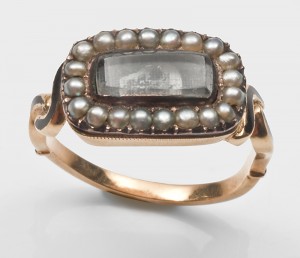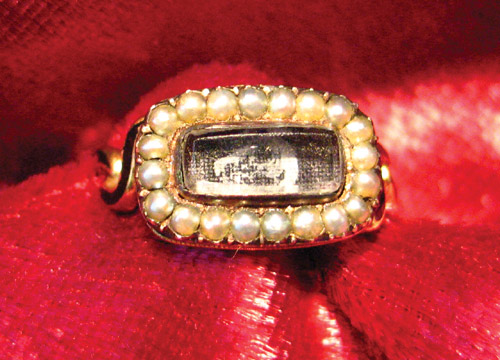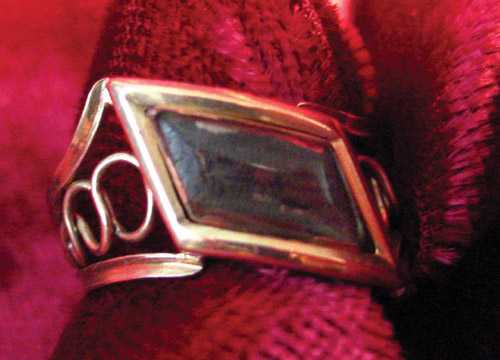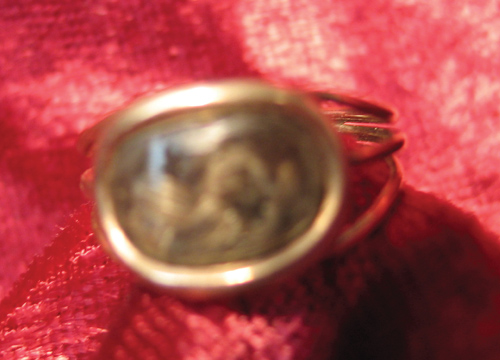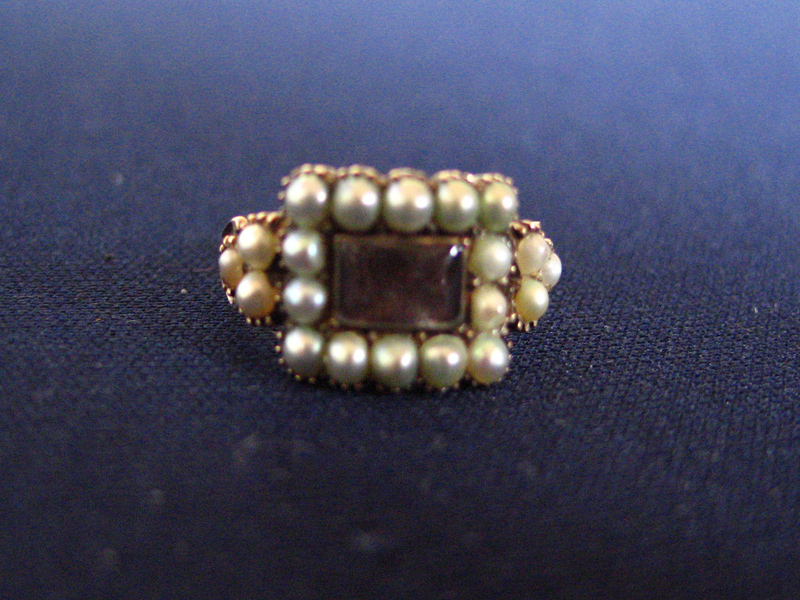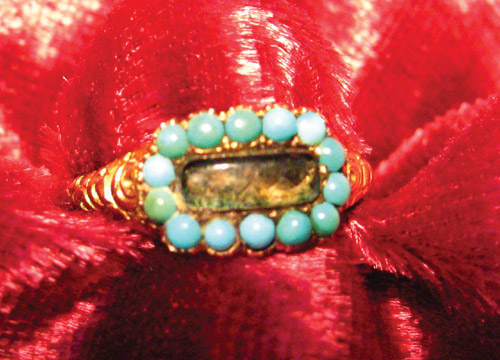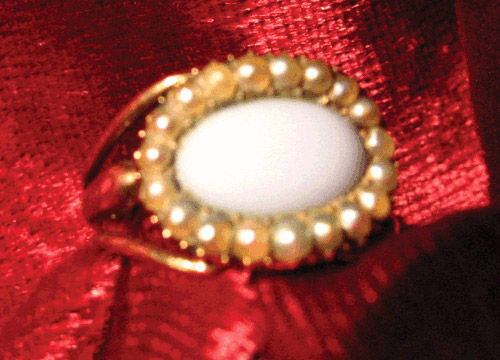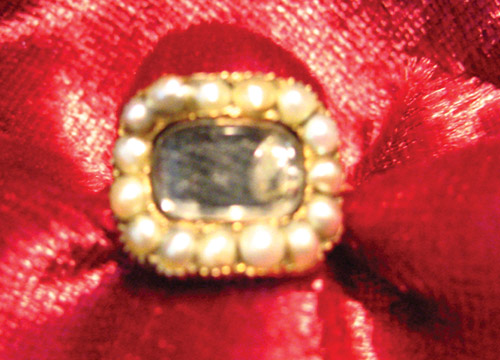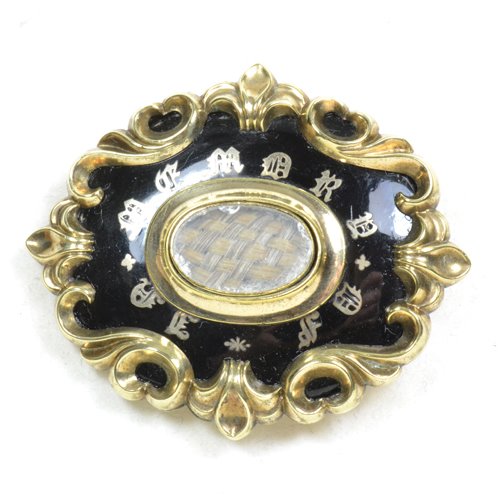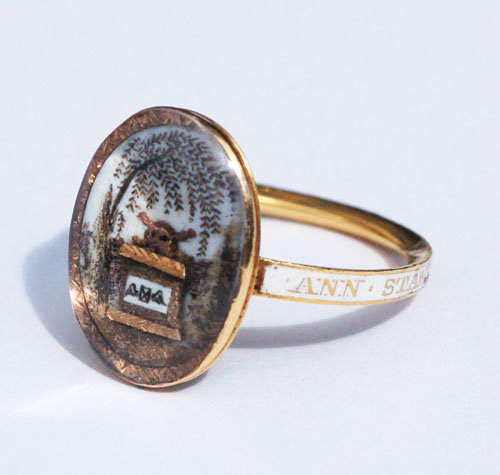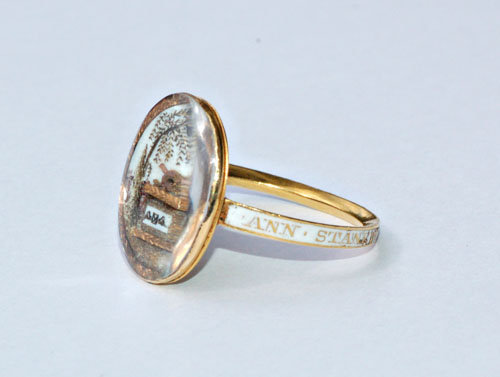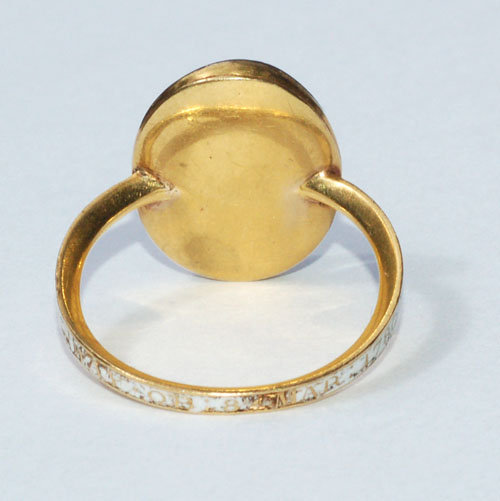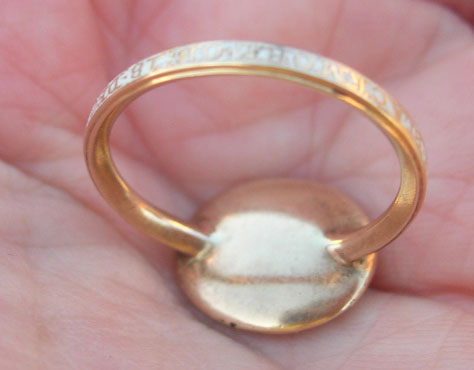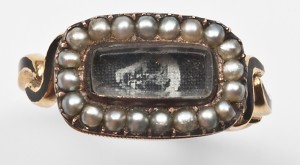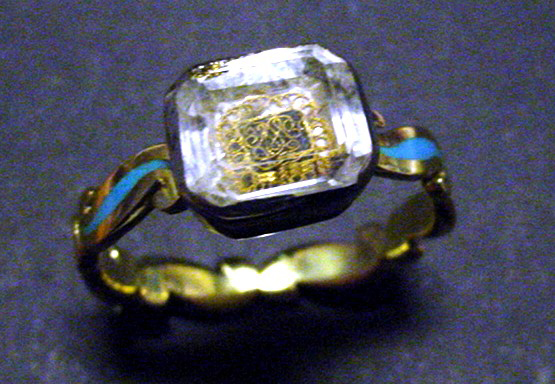Anachronisms and a Mourning Ring
Anachronisms, or pieces from the times that don’t correlate to when they are meant to exist, are quite typical of mourning jewels. From an identifier for a family’s culture and their representation of death, to a modern addition in a jewel that can change the tenant of its existence. Audiences who interpret symbols differently over time may alter a jewel that can represent their grief, while dealers may find it more lucrative to add the memento mori symbolism into a jewel for greater monetary reward.
In the nature of this article, we must appreciate several certain elements that lend towards the ring and why or why it may not be what it seems to be. Each of these elements are important for their historical value, even though there are oddities which put into question the reason of the jewel’s existence. It is through the jewels of modern tailoring that we learn more about the time of the jewels in which they are trying to represent. Seeing as this ring has a memento mori skull painted onto woven hair inside faceted glass, there are many questions as to the nature of what the ring was trying to achieve. Was this a ring made for modern times to replicate the memento mori nature in order to sell for a higher price? Is it a ring which resonates highly with the early 19th century to have a skull painted on it to cement the desecration on the body in a time when the magical properties of gems and the allegorical statement of death prevailed over the 19th century statements of ‘In Memory Of’ which the Gothic Revival would instil within culture?
Beyond these questions, the important elements are what the ring is trying to achieve. With many modern pieces which can be seen readily at antique sellers that are clearly replicas, there is an element of truth to their existence. These jewels are trying to capture a moment that we resonate with for an understanding of its time. Memento mori, being popular from the 17th to mid 18th century in jewellery, was intrinsic to its time of high mortality rate and incredible flux of political and religious movement. These identifiers in a time where a population could adapt to new wealth and change the paradigm of their existence through living for a deity under the ideal of being judged after death, to answering to a monarch who was challenged and utilising the rising industry to educate and advance new skills for wealth, led to their very fact. Death, in the scenario of its absolute symbolism of decay, were popular symbols to represent loved ones for the very nature of the relationship. They did die and their remains were gone.
Following on from c.1765, the Neoclassical period changed the paradigm of how death would be represented. From the symbols of death that memento mori had shown, the allegorical depictions of death as being a benign and romantic eventuality in jewellery was the common display of the afterlife. Where the skulls and crossbones had been, urns, weeping ladies and the willow tree had taken over. Leading to this ring, which would date from c.1815, the elements of how death was represented had changed once more. While the remnants of the Neoclassical period had retained the ideal symbolism of death, what jewellery had become was quite different. Now, there was the usage of pearls, jet, garnets, turquoise surrounding hair inlaid in woven hair bezels and more simplistic shoulders and bands.
For mourning jewellery collectors and scholars, this is quite a time to research. The early 19th century opens up a wealth of different styles for interpretation before the Gothic Revival period
Ovals, Rectangles and Early 19th Century Jewels
Let’s look at the following different interpretations of the early 19th century style of bezels and shoulder/bands in rings to see how the variation in styles led by the developing Industrial Revolution and new forms of creating these jewels created such a wide variety of ring types.
Experimentation of styles at the end of the Neoclassical movement created some unusual and quite beautiful forms of mainstream design in jewellery that were discontinued by the coming Gothic Revival and seemingly original for their time. Often, designs used in jewellery have some continuity or pedigree for their form, which makes their adaptation of any mainstream artistic flourishes seem quite understandable.
Yet, the early 19th century was a time of discovery and change. Much of the techniques used in traditional jewellery construction were being overtaken with the growing industrial revolution, production was growing to new levels, access to inexpensive materials transcended status to the point of social necessity. Hence, there was more room for experimentation in jewellery fashion, styles could exist for a short period and quickly disappear.
These particular rings show a motif in the shoulders and shank which have some basis in the navette style, but turn this into a design which is much more organic to the contour of the finger. While the style of the open wire/fretwork is a new one, it still honours the symbolism typical of its time.
With this particular ring, the symbolism in the eternity symbol is used to expand the shoulders, enhancing its simple symbolism and the nature of the design itself. What is more striking is that the ring’s memento area is shaped as a diamond, crossing diagonally around the finger. This also reflects upon the changing nature of the sentimental style of the time as well; what could also be a larger, ivory memento with a portrait or mourning/sentimental depiction is now the simple hairwork of the loved one, outwardly displayed for all to see.
Following on with this style, the wire-work open-shank can be seen in many other pieces of the first-quarter 19th century, with more or less elaboration. Often, the bezel is oval shaped with hairwork inside. This was at a time when the ‘Georgian Eye’ portrait was reaching its crescendo, suggesting that the oval and the eye have an intrinsic link in the design motif. Either way, it was phased out to become a more traditional rectangle, but keeping the same hairwork/materials inside.
One of the more fascinating aspects of ring design and motifs in the early 19th century is the increased use of gems and stones. What had previously been relegated to fine jewels was becoming ubiquitous and taking over as a symbolic motif in their own right. This was due to increased trade routes from Asia, creating an influx of materials which became cheaper. As is usual with changing styles, the ‘magical properties of gems’ put symbolic assignations towards the gems, so each had its own meaning.
Pearls are the most popular and common to find in rings (many bracelets were strung with pearls, but surviving pieces are harder to find). Jet and turquoise are two of the other most popular materials and are important for their use in mourning custom and symbolism.
Second and third stage jewels took very well to the enhanced use of colour, as reflective surfaces and colour were permissible, so hairwork jewels flanked with stones were not only an essential part of mourning, but a beautiful way to reflect and respect the loved one.
These became prevalent from around 1810 and lasted well into c.1850, where larger, bolder styles and black enamel facilitated the changing fashion.
This ring, with its chalcedony interior and pearl surround, has open shoulders, with each of the three prongs housing the bezel, which is curved to the contour of the finger. As a style, this evolved from the larger late 18th century bands, which held large bezels. Bezels became so large by this time that they were spanning knuckle to joint of the finger. Neoclassical depictions of love, painted in colour or sepia were set inside the rings, hence why they needed to become so large. As this style retracted and rings began to simply house a jewel or hair inside its memento area, the various design elements of the ring began to develop.
Within a period of twenty years (c.1800-1820), the bezels became rectangular, but the general style and construction remained the same. Compare the ring from 1801 above with the ring below:
And you can note the similarities. While this ring is more elaborate in its continuation of pearls along the shoulders, the general conceit of the ring is the same. Pearls, central area for hairwork or gem and dedication underneath.
This style remained popular until the mid-19th century and was used until the end of the 19th century in style, due to its ability to adapt and its sentimental simplicity. There was no need to change a style that was geared towards the personal sentiment of love, as the hairwork was placed in the centre and worn proudly outwards.
Do note that the use of other materials than hair in the dedication area of these pieces can often be later amendments. These rings are highly marketable when there is no clear indication of being for mourning or sentimentality (modern sellers often equate hair with death), so the hair and glass are easy to replace with a stone and when the surrounding pearls/turquoise/jet are still there, they are quite beautiful and command a good price.
This piece from around 1820 shows the same prominent hair memento as the previous pieces, but is much larger in scale. The shank is much more slender than earlier pieces.
One of the most important things needed to identify early 19th century rings and jewellery in general (such as the very popular brooch) is the rectangular shape. This is a shape that morphed from the earlier 19th century Neoclassical oval/navette shape which was a wonderfully large container for Neoclassical depictions on vellum and ivory. Painted depictions of sentimental displays of love and mourning were quite popular, as well as portraiture.
Around 1810, the change in style and the greater production of jewellery, due to higher social mobility and greater production, led to easier accessibility of love tokens, such as this ring. The need to have intricate (or even naive) sentimental depictions became less important than the hair memento itself, with the use of materials surrounding the hair beginning to rise.
One thing that is important to reflect upon is just what those jewels surrounding the hair mean for the wearer and the symbolic implications for the hairwork itself. One must start to ask what stage of mourning the piece may have been worn in; was it Jet, turquoise? Were there diamonds employed? Yes, the shape of the memento makes them easy to spot, but the greater questions opened up by the materials leads to greater questions on symbolism and social status.
George IV and the Influence of the Arts
All of the previous jewels could not have been if there wasn’t a heavy investment in the arts. Jewels require a level of wealth to be instilled within the culture into an industry of growing artists and skills that could develop and produce such high numbers of mourning jewels.
In the 1820s, many influences upon society offered greater cultural flexibility within the social structure. The excesses of George IV and his investment in the arts bought new influences into the United Kingdom. From the death of Princess Charlotte who died in 1817, mortality was absorbed as a cross-cultural, kingdom-wide event, imposing values of the affectations of mourning on people which would resonate for the remaining 19th century. The values that were appropriated to show this in fashion led to the Gothic Revival being the identifier for grief and virtue, due to its return to religious values and simplicity that takes that pomp away from the fact of death.
The Gothic Revival period of the early 19th century is an extremely pronounced period of obvious consequences in art and architecture, but also heavily affecting in morality and cultural lifestyle. It is a period that overlapped other forms of mainstream style to eventually become the dominant visual presence, particularly in memorial jewellery and had left its mark for the greater part of the 19th century.
Firstly, we must look at this emerging style to conflict directly with the ideals of the Neoclassical period. Though the Neo-Gothic movement had begun c.1740, it took around sixty years for it to reach mainstream thought, a time when Neoclassicism was at its height.
Much of this thought was a reaction to religious non-conformity in an effort to swing back to the ideals of the High Church and Anglo-Catholic self-belief. This was a time when heavy industry was on the rise and modern society (as we consider it today) was established, a time of radical change that challenged pre-existing ideals of society. Though there had been growing small scale social mobility from the late 17th century, the late 18th and early 19th centuries saw the middle classes having the opportunity to promote through society with the accumulation of wealth. Augustus Welby Northmore Pugin, a designer, architect and convert to Catholicism, saw this industrial revolution as a corruption of the ideal medieval society. Through this, he used Gothic architecture as a way to combat classicism and the industrialisation of society, with Gothic architecture reflecting proper Christian values. Ideologically, Neoclassicism was adopted by liberalism; this reflecting the self, the pursuit of knowledge and the freedom of the monotheistic ecclesiastical system that had controlled Western society throughout the medieval period. Consider that Neoclassicism influenced thought during the same period as the American and French revolutions and it isn’t hard to see the parallels. The Gothic Revival would, in effect, push society into the paradigm of monarchy and conservatism, which would dominate heavily throughout the 19th century and establish many of the values that are still imbued within society today.
Much of the latter 19th century pieces had their origin in this Gothic Revival period, the bold styles with black enamel as well as being larger accommodated the evolution of female fashion, which heavier crinolines and cuffs, seemed to be a perfect fit. Styles didn’t automatically become larger due to the Gothic Revival influence, much of the older styles adapted Rococo acanthus designs and incorporated Gothic fonts into the lettering of the dedication in the pieces, which emerged around the c.1800-1810. By the 1820s this style was influencing brooches, rings, pendants and lockets more and more, until the 1830s when it reached its height, particularly in terms of diversity. Through the 1840s it had become the standard and into the 1850s, there was the Hallmarking Act of 1854 that allowed the use of lower grade alloys. Reflecting this upon the larger styles of female dress, pieces could be larger and lighter to wear, yet still give all the bold, gold and black enamel prominence of the pieces themselves.
Understanding the time in which a jewel was made lets us understand why it exists and what its peers would have looked like. Insights that can be gained from this help in justifying the validity of a jewel, as anything replicated often takes away the mainstream flourishes of design, but neglects the finer details. Knowing that the ring of today’s article is suggested to have been created at a time between the end of the Neoclassical period and the transition to the Gothic Revival period, where jewels of rectangular shape and focus on gems would create something which looked like it allows its appreciation in design.
Skulls, Memento Mori and Anachronisms
Simply because a jewel shows signs of being incongruous with its symbolism, we must look beyond this and see how this is reflected in historical pieces to show that not all jewels are simply products of their time. There is a personal investment in a mourning jewel that speaks to the nature of family beliefs and systems. While there had been a massive flux of beliefs and challenges to identity, religion and politics over the 16th and 17th centuries, the 18th century displayed its ideas through its symbolism. With the Age of Enlightenment and the focus on Greco/Roman art, the traditional affectations of mourning became appropriated with art that directly looked at the symbolic love between people and not through the conduit of religion.
Concepts such as this are popular in their thought, but don’t simply replace the values of a family. This is why jewels made after c.1765 can have a varied interoperation of death and often blur the popular ideals of art with the previously seen memento mori.
In the above piece from the collection of Marielle Soni, this ring (c.1780) combines the classical motifs with the memento mori symbolism.
With all mourning and sentimental jewels, one must ask the following questions: what is the nature of the symbolism, why is it used, why would it have been commissioned and how would it have been worn?
Firstly, let’s look at the facts. The ring is dated 1780 and dedicated to Anne Staneway Obt 8 Mar 1780 AE 20. There is white enamel, domed crystal, the sepia painting and high relief tomb motif with the skull and crossbones on top, painted on the tomb is ‘tempus fugit’ (or ‘time flies) as the winged hourglass . There is the willow, cypress and all this sits underneath a piece of domed crystal. The bezel measures 3/4 inch by 1/2 inch and the band is 1/8 inch wide.
Judging from the construction, this piece is in quite original condition. Much of the time, sepia in such fine condition has been doctored with pieces today in order to repair or fetch a higher price, also, the crystal is another telltale sign that there has been some repair work. Often, glass has replaced with bevelled edges, as it’s much harder and more expensive to replicate this. From this piece, right down to the wear of the white enamel, it’s as it was and as it should stay. Visually, to see the richness of the white ivory and the enamel together really make the sepia and high relief gold/hairwork pop out at the viewer. This piece was made at a time of experimentation with the Neoclassical style, so much of these practices were still being understood before they became common in production.
Which leads us to the date. This piece stems from 1780, a time when Neoclassicism had become entrenched in mainstream culture and thought. Death, for its morbidity and harkening back to earlier times of less affluence and social mobility, had lost the memento mori symbolism. The meaning of the memento mori symbolism, while still in use somewhat for trinkets to denote the original intent (of understanding mortality), rather than be staunch reminders of death that had been popular in previous generations. This is why this ring is such a curiosity. Personally, anachronisms in design and art are very important to their time and show how much of the person who commissioned the piece influenced what it was. Finding memento mori symbols from this time is a hard thing to do, there were several small revivals, but this is quite personal. The tempus fugit with the original skull and crossbones on top of the Neoclassical symbols shows a direct marriage of style and prominence, the level of grief overtakes the beauty in death Neoclassical depictions would allude to.
Over to the border of the bezel, note the triangular pattern. This is a pattern and style that pops up quite frequently in contemporary jewellery and is a common setting. Much of the 1790s pieces lost of the order and made the ivory go directly to the edge of the bezel, however, this isn’t a rule. This particular style can be isolated to region and maker, but it did carry across to other forms of jewellery, such as brooches and pendants, either way, it’s quite an elegant way to encapsulate the interior and break away from the shank.
Underneath, the shank connects to the bezel very cleanly, no repair work or obvious joins, showing another sign of quality. Then there is the interior roll of the band. This carried over from the 1760s and is a good way to check for genuine age (in non enamelled pieces that may or may not have the obvious joins to the bezel). This style wasn’t greatly used through the 1790s, as the navette shape became more popular and larger, hence the curved-form fitting cuff shape to the finger was necessary to hold the ring to the finger as it was to look beautiful. This ring, with the oval shape and the rolled inner band really speaks for the height of its time.
The symbolism speaks largely for itself, the willow is sadness, the tomb/plinth shows the mortuary, skull and crossbones is death, the tempus fugit shows that time flies, cypress points towards the heavens and the white enamel is for the unmarried/virginal Anne Staneway. To apply some sort of subjective consideration to this, one may consider that the ring was commissioned by a parent for family member, but one may consider that it was for an older member of the family who still had resonated with the anachronistic thought of the previous generation’s memento mori motifs. Complete supposition, however, as there is no evidence to back this up and it may as well have been sold directly from a pre-painted ivory.
For more information on Anne, she was the daughter of John and Edith Stanaway the daughter of John and Edith Stanaway [n.b. non-standardised 18th century spelling] and born in Melcombe Regis, Dorset, England in 1760.
Quite a popular ring utilising quite popular symbolism. Further to this, the following ring from 1770 is another piece created at a time when many would consider its style to be out of date.
Over the most recent Rococo articles, much has been written about the abrupt change-over into new art styles, particularly from the period of 1720, with Baroque to Rococo, and then in 1765 with the introduction of Neoclassicism.
One area that I would like to dispel, is that a change in style, no matter how popular, did not effectively kill a style off. Styles lingered, sensibilities did remain and to consider that an entire moment in time could change a global perspective is absurd. While styles that remained were obscure and could be considered anachronisms for their time, one must analyse these particular areas to understand why a jewel exists:
Money
Simply put, it was the society that could afford to change their jewellery with the times which effectively created our current understand of style in jewellery. Why is this? The more that were produced would be the ones more likely to remain today and the ones we commonly associate with the time. Neoclassical, while immensely popular didn’t cause jewellers to throw away their moulds to produce a new style overnight. The cost in changing machinery and learning new styles is enough to consider how necessary it would be on a return on investment status. Jewels that were re-appropriated from the previous generation were also used or kept, as they held intrinsic value to the memory within the family.
Age
The age of the people who were wearing the new styles of jewels in their social environments would be the ones to adapt to the popular jewels. While state and court styles were largely mandated, the enforcement on a culture of the 18th century that was learning about profit and social mobility would be difficult to holistically maintain. If an older, more ecclesiastically minded person of the previous generation who didn’t relate well to the Neoclassical movement and was more engaged by the representation of death in the Memento Mori style, then it would not be uncommon for a jewel to be commissioned with this older style. Just because a matter of several years had passed with a symbol falling out of favour, it would not disappear.
Social Tastes
In the end, society and its standardisation of style was the important thing. Yes, styles changed in much broader ways because of this, but older styles, such as this ring would exist. It’s clearly the Rococo ribbon/scroll band, a style that adapted well into the 19th century with more straight edges, but retaining the dedication around the band itself. Yet, here it is in 1770, a good step into the Neoclassical movement, but not following its popular trend.
This is why, when it comes to viewing a jewel, it’s easy to put it into context of its time, but to be completely definitive is difficult without a hallmark stamp or dedication.
Appreciation of the Jewel
All of these elements make a ring which could seemingly be overlooked. At no stage can something be taken for granted, as even the most simple ring can have the longest tale. From elements that may have been doctored by a seller to enhance its price, to the elements which can tailor a mourning jewel to be repurposed by a new owner for mourning sensibilities, the truth remains; these jewels are made for the purpose of mourning. Death is the absolute to reflect why a mourning jewel came into existence. Unless it is simply for the purpose of collecting, these jewels are appreciated for an intelligent purpose and either used again for the purpose of memory or simply loved for their ability to capture a specific time and memory of a person. Never look at a jewel and think it is arbitrary; all statements worn on the body are for a purpose. It is how we want to be presented in society and how we want to capture a memory of a time, be it for nostalgia, love or both. Look to these jewels with all the sentiment that was given to them and share their love through the ages.




